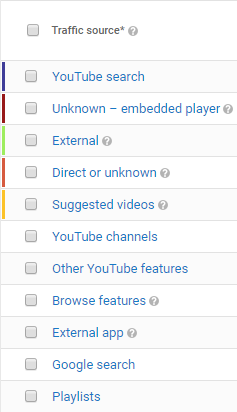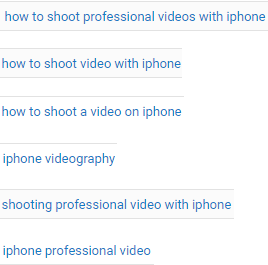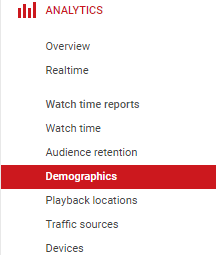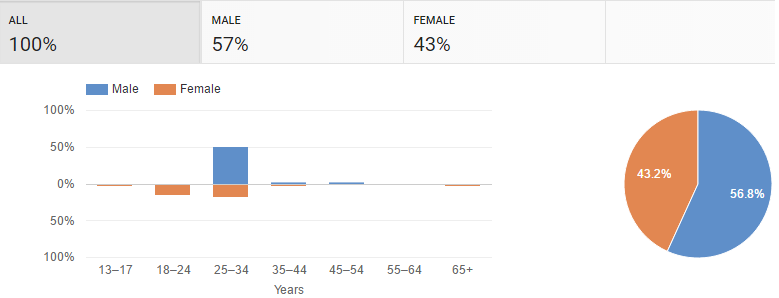Sorting through the numbers and charts of your YouTube Analytics dashboard may seem like a daunting task for the neophyte video marketer. After all, you’re likely aiming to identify patterns and trends, understand behavior, and optimize video conversions.
Keep these themes in mind when approaching your data:
Viewer intent
What is your viewer trying to accomplish by watching your video? Ask yourself:
-
Why is she there?
-
How did she get there?
-
Is she an ideal buyer?
-
Where is she going after this?
Understanding various viewer mindsets and motivations helps you construct more accurate video buyer personas. You’re then able to create actionable content and offer more effective value propositions for real people.
Take a look at your YouTube Search filter under Traffic Sources:

Here, you’re able to see semantic search data and its corresponding watch times, average view durations and average completion rates. Why is this important? It’s actual keyword terms and phrases being used by audiences interacting with your content!
Here’s a quick look at some of the common terminology concerning one of our iPhone video tutorials:

Exploring each term affords you the opportunity to examine cross-sections based on geography, date, and subscription status. This information can be used to tailor your video marketing strategy to specific countries and regions. You’re able to identify high or low performing areas and emerging leads based on search intent.
Let’s say you’re a firm based in the northeastern United States with most of your revenue originating from this area. You’re excited to discover new breakthroughs based on search intent but you want a fuller picture of these potential customers.
Cross-reference the Demographics portion of YouTube Analytics:

Filter your results by date range (e.g. last week, 28 days, 30 days, month, 90 days, quarter, etc.) for context. For example, maybe you’d like to see demographic activity based on a specific state within the first 30 days of publication. You love your audiences across the country (and around the world) but you really love those folks watching in your territory.

You decide to focus on data from New Yorkers:

Further dives into Playback locations, Devices, and Audience Retention will lead to even greater contextualization. It’s not just your video marketing strategy either. Understanding this lexicon improves your overall content marketing perspective. You can create new supplements and complements (e.g. infographics, blog articles, case studies, etc.) based on the search interest. These helpful add-ons may be linked in the video’s description, Annotations, or Cards as an additional call-to-action.
Remember: YouTube Analytics are far from complete. You’re gaining knowledge of user behavior on one of your platforms. Are these the right type of buyers who would even act on your offer? Compare your findings with data from your other touchpoints for a more holistic portrait of your ideal (and not ideal) audiences.
Urgency
It’s no surprise to say that you’re competing with literal lifetimes-worth of video content.
On the other hand, maybe you’re publishing video content in a very niche space with few visible competitors. You’re the big fish in the pond. You’re not really competing with makeup tutorials, FPS streaming, or cooking breakdowns.
You’re right. You, the homeowners insurance specialist or contracts coordinator, aren’t facing off with these disparate categories.
However, your root problems are.
“Root problems”? In addition to “share of mind” or “share of wallet,” you and your value proposition are competing in “share of problem solving.” Here, the viewer is determining which problems or difficulties must be addressed and in which order are they confronted.

Your ideal viewer is tasked with determining how important or pressing the problem is and how it will be fixed.
Everyone has a fatigue point. Here, a looming juncture reaches such a saturation of combined annoyance, frustration, and anxiety that it’s relegated. Maybe the person doesn’t know where to start and feels overwhelmed. Maybe he’s dissatisfied with the available choices.
Educating viewers and articulating your value proposition goes a long way in helping audiences establish timeframes, set expectations, and make critical decisions.
Reducing anxiety or uncertainty empowers viewers. Empowerment reduces hesitation and other barriers to action, allowing people to approach issues with confidence. Here, your value proposition won’t take a backseat, be sidelined, or avoided by procrastination. You’ve presented the situation in a straightforward, easy-to-understand manner. You’re guiding somebody from doubt to certainty.
Ownership
How invested are your viewers? Are they watching actively or passively? What’s the difference?
These aren’t permanent states. A person can actively or passively consume your content given their interest in the subject matter. Interest can be a function of several variables like urgency to solve a problem, existing knowledge level, boredom, competing noise, and other factors.
Passive viewing is the most basic level of involvement with a video. You’re there, watching. Perhaps you’ve formed minimal expectations of the video based on its title or a description a friend sent you. You have minimal knowledge of the video and you don’t really care to investigate further before playing.
Some actions may occur after watching. Creators might see sporadic clickthrough activity on certain calls-to-action based on the offers. Maybe it’s good enough to share.
What complicates passive viewing is the presence of distractions. They could be other pieces of content published by competitors. Maybe they’re completely unrelated to the task at hand (e.g. did I remember to – SQUIRREL! – cancel that appointment?). Quality attention is diverted from your work to a more prescient concern.

Active viewing is a commitment. You choose to invest more energy in addressing a video. Maybe you re-watch it several times to pick up details ignored during previous plays. You end up spending a good deal of time interacting with its messaging.
What differentiates passive and active viewing besides distractions or prior interest is the level of subsequent engagement and post-view activity. The passive viewer may appreciate the video and do nothing else. She simply moves on to something else.
The active viewer takes next steps. She scans your video’s description. She acts on your CTA. She arrives at your landing page. She subscribes to your channel. She shares it with her network on LinkedIn. She likes your work and leaves a comment. She visits your site and subscribes to your newsletter. She buys from you.
Obviously this is an idealized example of what could go right with a truly engaged visitor-turned-prospect-turned-lead-turned-customer. However, there are tiers to active viewing. Some people may be more invested than others due to a greater urgency or previous contextual understanding. Maybe your style/approach/offer aligns better with one person and not another.

With this in mind, your video marketing strategy needs to foster ownership where audiences identify their problems and seek your expertise for education, direction, and resolution. Set these foundational goals:
-
Motivate passive bystanders to become active participants
-
Retain active audiences at highest investment levels
-
Direct action to more valuable offers
Combing through YouTube Analytics (in context with your other data suites) helps you position video’s role in your conversion strategy. Here, you’re able to understand where and when viewers play your videos. Next, you can determine how effective your offers and video value propositions are when assessing conversion rates and other KPIs. Identifying behavioral insights leads to the creation of better, more valuable content.


